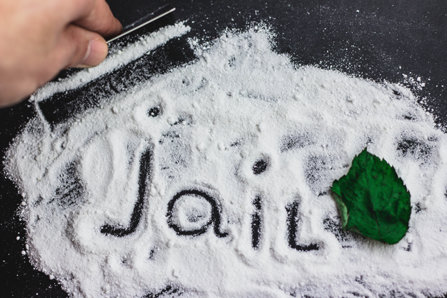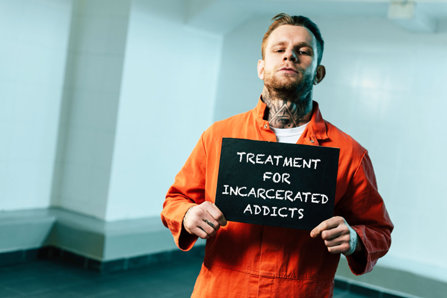Should a Jail Be Responsible for Treating Addiction?

When I checked the news the other day I was shocked to find a story of a federal judge who ordered that a county jail in Massachusetts be made to give an inmate his methadone doses, so he could continue his medication-assisted therapy. If we start giving addicts habit-forming drugs like methadone while they are in jail, who’s to say if those addicts will ever find freedom from chemical and psychological dependence on substances? I understood the judge’s compassion to help the inmate, but I believe the judge went in the wrong direction by mandating methadone treatment. A better route would have been real drug and alcohol addiction treatment—not medication-assisted therapy which just keeps individuals on an addictive, but legal, drug indefinitely.
How One Federal Judge Set a Precedent for Methadone in Jail Cells
What happened was that earlier this year, Geoffrey Pesce, a regular methadone patient, sued the head of Essex County’s House of Correction in Middleton, Massachusetts as well as the county sheriff. Geoffrey was assisted by the American Civil Liberties Union of Massachusetts.
Geoffrey insisted that he should still be allowed to receive his methadone while in jail, even though administering methadone to inmates in a prison setting raises all kinds of security, fiscal, and logistical concerns. But U.S. District Court Judge Denise Casper heard Geoffrey’s case and ruled in favor of him, commanding the county jail to provide Geoffrey’s methadone to him. I’m sure Judge Casper’s heart was in the right place, but I don’t believe she made the right decision.
As one can imagine, this sets a precedent for the entire nation. If one jail is now forced to dole out highly addictive pharmaceutical medications to its inmates, how long is it going to be before the rest of the county jails, state penitentiaries, and federal prisons all across America are made to do this?
In the words of Sally Friedman, the vice president of legal advocacy for the New York-based Legal Action Center, “This is the first time a court in this country has ruled that failure to provide medication-assisted treatment in the criminal justice system can violate the ADA and the Constitution.”
But how can failing to provide medication to an inmate be a violation of the Constitution when that medication is just going to make their condition worse, not better? Slapping the label “medication” on methadone should not automatically give it constitutional protection. You could also slap the label “heroin in a medicinal form" on methadone and it would be just about as fitting a title, and then it definitely would not be under constitutional protection.
It is true that addicts should have a right to treatment. It is true that withholding that right to treatment should be a violation of the ADA and the Constitution. But the error here is on the kind of treatment that we give them. Putting recovering addicts on highly addictive meds like methadone is really just trading one addiction for another. Therefore it is not treatment at all—not by any sense of the word. The judge in this instance had her heart in the right place, but she did not provide a real solution for the man. She wanted to ease his suffering, but she went about it in the wrong way.
Addiction and Incarceration – The Problems Run Hand-in-Hand

Addiction, drug use, drug crime, and incarceration often run hand-in-hand. When we examine data from the Federal Bureau of Prisons, the proof comes out in just how many inmates are locked up in federal prisons for drug offenses. According to the Bureau, there are currently 77,649 individuals kept under lock and key in federal prisons for drug offenses.
That number sums up to 46 percent of total inmates—i.e. the highest percentage of inmates locked up for the same charge. The next closest group is criminals locked up for crimes involving weapons, explosives, or arson; a group which only comprises about 18 percent of the total, federal incarcerated population.
Granted, not all of these inmates are also drug addicts, but many of them are.
The problem gets worse when we zoom out the camera lens a bit and focus more on the total number of people incarcerated in America for drug-related charges, not just those in federal prisons. According to the Center for Prisoner Health and Human Rights, in 1980 only about 40,900 people were incarcerated in the U.S. for drug offenses. By 2013, thirty-three years later, that number had skyrocketed to 489,000—an increase of more than 1,000 percent.
The Center for Prisoner Health and Human Rights also saw fit to note that the vast majority of drug arrests are for possession—not dealing, not violence while on drugs, not gang activity, not theft or murder or assault and battery, breaking and entering, etc. The vast majority of drug arrests are addicts who are caught with drugs on them. This makes for a huge percentage of the prison population being comprised entirely of addicts. It’s already wrong to incarcerate drug addicts, but to then court-order that those addicts be doped up on “replacement medications” is surely preposterous.
Medication-Assisted Therapy Is Not a Solution
We have to continue to develop real alternatives to drug addiction, i.e. workable, affordable, accessible, and encouraged residential treatments for drug addiction.
Drugs like methadone fall under a category called “medication-assisted therapy,” or “medication-assisted treatment,” (abbreviated MAT). The idea behind medication-assisted therapy is that, because addiction is such a tough, brutal devil to beat, some addicts need a little extra help in doing so, hence the “assistance” of medication.
One of the primary failing points of medication-assisted therapy, however, is that the drugs used in MAT programs are themselves addictive. Methadone is a full opioid agonist, and it has many of the same properties and addictive potentials as opioid painkillers and heroin. Methadone is also, itself, a pain reliever. MAT hardly even looks good on paper, and in actual practice, it usually just ends up being the constant merry-go-round of trading one drug for another.
A Better Solution Would Be Treatment for Incarcerated Addicts

If we are going to have addicts in our prison system, (which we really shouldn’t, but that’s a different topic entirely), we should be treating them for their drug habits, not feeding their habit by giving them a replacement medication that they can transfer their addiction to. Even if the individual was already on a MAT program before going into jail, why continue to give him or her an addictive pharmaceutical? Why start bringing supplies of addictive pharmaceuticals into prisons, which by itself is a huge accident just waiting to happen? There are far better and more effective ways of treating people who struggle with opioid dependence.
A better solution would be to offer treatment programs within jails. If addicts coming into prison have to come down off their meds, their drugs, their alcohol, etc., they should have access to withdrawal programs that are more than just a cold turkey detox. And after that, addict-inmates should be able to receive rehabilitation care and treatment services, or they will likely go back to using drugs again once they get out of prison.
In fact, according to the Massachusetts Department of Public Health, opioid-related overdose deaths among former Massachusetts inmates are one-hundred and twenty times higher than they are among the rest of the adult population. If we are going to incarcerate addicts, then we need to use their jail sentence as an opportunity to treat them for their addiction, not medicate them on addictive drugs at the taxpayer’s expense.
Sources:
- https://www.usnews.com/methadone-order-by-federal-judge-in-massachusetts-may-ripple-nationwide
- https://www.bop.gov/about/statistics/statistics_inmate_offenses.jsp
- https://www.prisonerhealth.org/incarceration-substance-abuse-and-addiction/
Reviewed & Edited by Claire Pinelli, ICAADC, CCS, LADC, RAS, MCAP


 ®
®